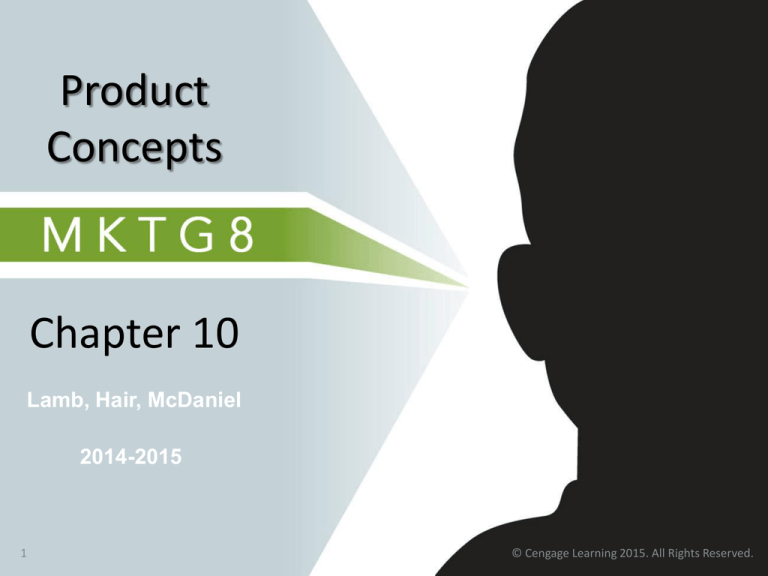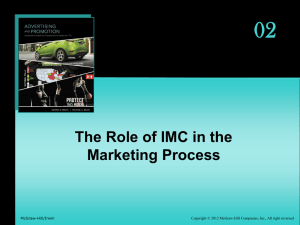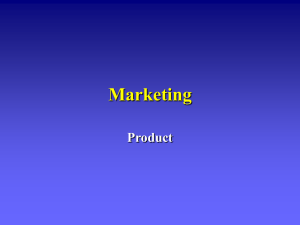
Product
Concepts
Chapter 10
Lamb, Hair, McDaniel
2014-2015
1
© Cengage Learning 2015. All Rights Reserved.
• Define the term product
• Classify consumer products
• Define the terms product item, product line, and
product mix
• Describe marketing uses of branding, packaging
and labeling
• Discuss global issues in branding and packaging
• Describe how and why product warranties are
important marketing tools
© 2015 by Cengage Learning Inc. All Rights Reserved.
2
What Is a Product?
Everything, both favorable and
unfavorable, that a person receives in an
exchange.
•
Tangible Good
•
Service
•
Idea
1
© 2015 by Cengage Learning Inc. All Rights Reserved.
3
Core Vs. Augmented Product
SUPPORT SERVICES
COMPONENT
PACKAGING
COMPONENT
Repair and
maintenance
Trademark
CORE
COMPONENT
Product platform
Installation
Brand name
Legal
Legal
Other related
services
Price
Quality
Warranty
Design features
Functional features
Instructions
Deliveries
Package
Spare parts
Styling
Legal
Types of Consumer Products
Products
Consumer
Products
Convenience
Products
Shopping
Products
Business
Products
Specialty
Products
© 2015 by Cengage Learning Inc. All Rights Reserved.
Unsought
Products
5
Types of
Consumer Products
Convenience
Product
A relatively inexpensive item that
merits little shopping effort
Shopping
Product
A product that requires comparison
shopping, because it is usually more
expensive and found in fewer stores
Specialty
Product
Unsought
Product
A particular item for which
consumers search extensively and
Market
are reluctant to accept substitutes
Development
A product unknown to the potential
buyer or a known product that the
buyer does not actively seek
2
© 2015 by Cengage Learning Inc. All Rights Reserved.
6
Characteristics of Consumer Products
Type/
Criteria
Convenience
Shopping Specialty
Distribution
Intensive
Selective
Exclusive
Retail margin
low
medium
High
Consumer
low
Shopping time
medium
High
Purchase
frequency
high
medium
low
Inventory
turnover
high
medium
low
Support
services
low
medium
high
Product Items,
Lines, and Mixes
Product Item
A specific version of a product
that can be designated as a
distinct offering among an
organization’s products.
Product Line
A group of closely-related
product items.
Product Mix
All products that an
organization sells.
3
© 2015 by Cengage Learning Inc. All Rights Reserved.
8
Exhibit 10.1
Campbell’s Product Lines and Product Mix
Source: Campbell's Web site:
http://www.campbellsoup.com.
9
Optimum Product Mix Decisions
Optimum product mix decision of a company is the width
(number of product lines) and depth (items in each line) that
a company can carry considering the following factors.
–
–
–
–
–
–
Level of market/economic development
Sales/Profit
Competition
Market characteristics
Product characteristics
Legal considerations
It is an issue of “trade-off.” More lines or items can provide
increased sales but there is a cost of managing the line/item.
Adjustments
Adjustments to
Product Items,
Lines, and Mixes
Product
Modification
Product
Repositioning
Product Line
Extension or
Contraction
3
© 2015 by Cengage Learning Inc. All Rights Reserved.
11
Types of Product Modifications
Functional
Modification
Style Modification
Quality
Modification
Planned Obsolescence: The practice of
modifying products so those that have
already been sold become obsolete before
they actually need replacement.
3
© 2015 by Cengage Learning Inc. All Rights Reserved.
12
Repositioning
Why reposition
established
brands?
Changing
Demographics
Declining Sales
Changes in
Social
Environment
3
© 2015 by Cengage Learning Inc. All Rights Reserved.
13
Product Line Extension
Adding additional products to an existing
product line in order to compete more
broadly in the industry.
Symptoms of Overextension
• Some products have low sales or
cannibalize sales of other items
• Resources are disproportionately allocated
to slow-moving products
• Items have become obsolete because of
new product entries
3
© 2015 by Cengage Learning Inc. All Rights Reserved.
14
Branding
Brand
Name
That part of a brand that can be spoken,
including letters, words, and numbers
Brand
Mark
The elements of a brand that
cannot be spoken
Brand
Equity
The value of company and brand names
Global
Brand
A brand where at least a third of the
earnings come from outside its home
country
4
© 2015 by Cengage Learning Inc. All Rights Reserved.
15
Branding Strategies
Manufacturers’
Brand
The brand name of a
manufacturer.
Private
Brand
A brand name owned by a
wholesaler or a retailer. Also
known as a private label or store
brand.
Captive
A brand manufactured by a third
party for exclusive retailer,
without evidence of a that
retailer’s affiliation.
4
© 2015 by Cengage Learning Inc. All Rights Reserved.
16
Advantages of
Manufacturers’ Brands
• Heavy consumer ads by manufacturers
• Attract new customers
• Enhance dealer’s prestige
• Rapid delivery, carry less inventory
• If dealer carries poor quality brand,
customer may simply switch brands and
remain loyal to dealer
4
© 2015 by Cengage Learning Inc. All Rights Reserved.
17
Advantages of
Private Brands
• Earn higher profits on own brand
• Less pressure to mark down price
• Manufacturer can become a direct
competitor or drop a brand/reseller
• Ties customer to wholesaler or retailer
• Wholesalers and retailers have no control
over the intensity of distribution of
manufacturers’ brands
4
© 2015 by Cengage Learning Inc. All Rights Reserved.
18
Advantages
of Captive Brands
•
•
•
•
No evidence of store’s affiliation
Manufactured by third party
Sold exclusively at the chain
Can ask price similar to
manufacturer’s brands
4
© 2015 by Cengage Learning Inc. All Rights Reserved.
19
Individual Brands Versus
Family Brands
Individual
Brand
Family
Brand
Using different brand
names for different
products.
Marketing several different
products under the same
brand name.
4
© 2015 by Cengage Learning Inc. All Rights Reserved.
20
Co-branding
Ingredient
Branding
Types of Cobranding
Cooperative
Branding
Complementary
Branding
4
© 2015 by Cengage Learning Inc. All Rights Reserved.
21
Trademarks
A Trademark is the exclusive right to use
a brand. A service mark performs the same
function for services.
Many parts of a brand and associated
symbols qualify for trademark protection.
Trademark right comes from use rather than
registration.
The Digital Millennium Copyright Act
(DMCA) explicitly applies trademark law to
the digital world.
4
Companies that fail to protect their
trademarks face the possibility that their
product names will become generic.
© 2015 by Cengage Learning Inc. All Rights Reserved.
22
Functions of Packaging
Contain and Protect
Promote
Facilitate Storage, Use,
and Convenience
Facilitate Recycling
5
© 2015 by Cengage Learning Inc. All Rights Reserved.
23
Labeling
Informational
Persuasive
Focuses on
promotional
theme
Consumer
information is
secondary
Helps make proper
selections
Lowers cognitive
dissonance
Greenwashing
5
Attempting to give the impression of
environmental friendliness whether or not it
is environmentally friendly.
© 2015 by Cengage Learning Inc. All Rights Reserved.
24
Universal Product Codes
A series of thick and thin vertical
lines (bar codes), readable by
computerized optical scanners,
that represent numbers used to
track products.
5
© 2015 by Cengage Learning Inc. All Rights Reserved.
25
Global Issues in Branding
One Brand Name
Everywhere
Global Options
for Branding
Adaptations &
Modifications
Different Brand
Names in Different
Markets
6
© 2015 by Cengage Learning Inc. All Rights Reserved.
26
Global Issues in Packaging
Labeling
Global
Considerations
for Packaging
Aesthetics
Climate
Considerations
6
© 2015 by Cengage Learning Inc. All Rights Reserved.
27
Product Warranties
Warranty
A confirmation of the quality or
performance of a good or service.
Express
Warranty
A written guarantee.
Implied
Warranty
An unwritten guarantee that the good
or service is fit for the purpose for
which it was sold.
7
© 2015 by Cengage Learning Inc. All Rights Reserved.
28
Ch 10 Discussion Questions
1.
2.
3.
4.
5.
6.
What is a product? Explain Core and Augmented
Product.
Define the four types of consumer products. How can
we classify them using various criteria? Explain.
Explain the concept of product item, product line, and
product mix.
What is an optimum product mix decision? Explain the
factors affecting optimum product mix of a company.
What is a brand? Explain the rationale for branding
from manufacturer’s and distributor’s perspective.
What is packaging and labeling? Explain their benefits.







